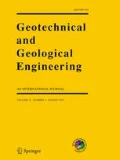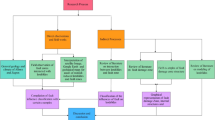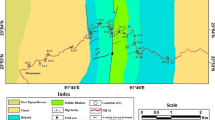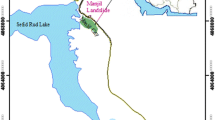Abstract
In this article, the interaction between active faults and landslide phenomenon is studied. The case study concerns the landslide in the east of Latian Dam to the northeast of Tehran, the Capital of Iran. The methodology was based on geological studies, geomorphologic studies, the study of landslide phenomenon including its characteristics and its parameters, hydrogeology, geological engineering and the geotechnical studies. The results show that landslide is located in the crush and mylonitized zone of the Roodehen active fault. The geological formation includes the landslides of the Eocene tuffs, which have been severely crushed and pulverized by the Roodehen Fault’s actions, and for this reason, they show very weak geotechnical characteristics compared to the natural tuffs. The layering slope of the formation is according to the natural ground slope and facilitates their slips. According to the results, the main reason for landslide is the impact of the Roodehen active fault and the creation of crush and mylonitized zone in the Eocene tuffs, while the secondary parameters are the local geological structures, the unfavorable conditions of the groundwater and their inadequate drainage and the construction of a road along the ground layers. The existence of groundwater, the low impermeability of the landslide materials and the inadequate drainage are also under the influence of the fault. Moreover, based on the results of this research and the location of the considered landslide and a number of others along the Roodehen Fault, it became possible to study the fault’s activity from a seismotectonic point of view and to estimate the magnitude of such an eventuality by methods other than the conventional ones.








Similar content being viewed by others
References
Akbari B, Fatemi M, Hashemi S (2003) Study of Kalin-Rud village landslide causes. In: Proceeding of the third Iranian engineering geology and environmental conference, pp 150–159
Bhalai S (2010) Landslide susceptibility of Portland, Jamaica: assessment and zonation. Caribb J Earth Sci 41:39–44
Conte E, Dente G, Guerrcchio (1991) Landslide movement in complex geological formation at verbicaro. Landslide, Balkena, London, UK, pp 47–53
Cote V, Hia C (1987) Earthquake-prone environment. Slope stability. England, pp 287–329
Creseenti U, Dramis F, Prestininz (1994) Deep-seated gravitational slope deformation and large scale landslides. Deparimento di scienz, storiadell, Architturae Restaaro, IAEG
Donati L, Turrini MC (2002) An objective method to rank the importance of the factors predisposing to landslides with the GIS methodology application to an area of the Apennines (Valnerian Perugia Italy). Eng Geol J 63(3–4):277–289
Elahpour E, Nasranadi A, Elahpour M (2006) Study of effective parameters on occur of landslide in Birjand area. In: The international conference on geohazards, natural disasters and methods of comforting with them. Tabriz, Iran, pp 40–50
Fan M, Chen K, Rober I (1996) Weathering effect on the geotechnical properties of argillaceous sediments in tropical environments and their geomorphologic implications. Earth surface processes and landforms, vol 21. Wiley, England, pp 49–59
Farhodi G, Derakhshani R (1999) Applied morphotectonic analyses due to active faults determination around structure. In: The first conferences of engineering geology and environment of Iran, pp 179–188
Ghamgosar M, Bagheri M, Nazarnejat M (2006) Study and geomechanical analyze of unstability factors of Emamzade Ali area in Haraz road. In: Proceeding of 4th Iranian conference on engineering geology and the environment, pp 192–202
Ghayomian J, Jalali N, Zandi F, Aaaaaporkermani M (2003) Lineaments extraction from remotely sensed data and its relation to landslide occurrence in Taleghan region. Pajouhesh Sazandegi J 58:75–81
Hancher SR (1987) The implication of joints and structures for slope stability. Slope stability. Wiley, England, pp 45–185
Harp E, Jibson R, Kayen R, Keefer D, Sherrod B, Carrer C, Collins B, Moss R, Sita N (2003) Landslides and liquefaction triggered by the M 7.9 Denali fault earthquake of 3 November 2002, GSA Today, August 2003, pp 4–10
Hosseini SA, Lotfian M, Kaviani A, Porsakhoo A (2011) The effect of terrain factors on landslides features along forest road. Afr J Biotechnol 10:14108–14115
Keefer DK (1984) Landslide caused by earthquakes. Geol Soc Am Bull 45:404–421
Letto F, Donato FF, Letto A (2007) Recent reverse fault and landslides in granitic weathered profiles Serre Mountain (Southern Calabria, Italy). Geomorphol J 87(39):187–206
Li Y, Yang J, Xia Z, Mo D (1998) Tectonic geomorphology in Shanxi graben system, Northern China. Geomorphology 23:77–89
Marques F, Maltildes R, Redweik P (2011) Statistically based on cliff instability hazard assessment of Bourgau-Logos coastal section (Algarve, Portugal). In: Proceeding of 11th international coastal symposium. Szczecin, Poland. J Coastal Res S164:927–931 (ISSN 0749-0208)
Matsukuras Y, Mizuno K (1986) The influence of weathering on the geo-technical properties and slope angles of mudstone in the Mineoka earthquake area. Earth surface processes and landforms, vol 1. Wiley, England, pp 263–273
Menges C (1993) Soil and geomorphic evolution of bedrock facts on tectonically active movement in front, western de Cristo Mountain. Geomorphology 3:301–332
Morisawa M, Hack I (1984) Tectonic geomorphology. Hyman Publication, USA
Panek T, Hradecky J, Minar G, Silhan K (2010) Recurrent landslides predisposed by fault induced weathering of flysch in the western Carpathians, Gedrosia society, London. Eng Geol Special Publ 23:189–199
Yuan CC, Chien YF, Chi LS (2005) Analysis of time-varying rainfall infiltration induced landslides. Environ Geol, 466–479
Zomorrodian M (2004) Geomorphology of Iran. Ferdowsi University Press, Ferdowsi, p 78
Author information
Authors and Affiliations
Corresponding author
Rights and permissions
About this article
Cite this article
Khorsandi, A., Ghoreishi, S.H. Studying the Interaction Between Active Faults and Landslide Phenomenon: Case Study of Landslide in Latian, Northeast Tehran, Iran. Geotech Geol Eng 31, 617–625 (2013). https://doi.org/10.1007/s10706-013-9612-z
Received:
Accepted:
Published:
Issue Date:
DOI: https://doi.org/10.1007/s10706-013-9612-z




